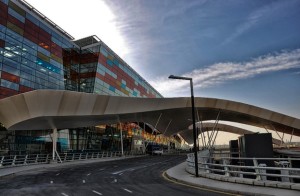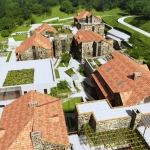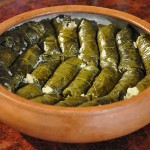
Thanks to the new terminal, which opened on September 17, 2011, Zvartnots International Airport has doubled its capacity. It can now serve up to 3.5 million travelers per year. The new complex is spread over 34,000 square meters. Over the past four years, more than 70 billion AMD has been invested into the Armenian air travel industry, amounting to double the investment made from 2003 to 2008.
Military development is one of Armenia’s top priorities. Today, the Armenian Military is armed with some of the most modern weaponry. Over the past three years, the military purchased more weapons and ammunitions than it had in the fi fteen years prior.
The opening ceremony of the Wings of Tatev aerial tramway took place on October 16, 2010. This 5.7-kilometer-long engineering marvel, which glides over the Vorotan river gorge towards the 9th century Tatev Monastery, is the longest reversible aerial tramway in the world. It was built as part of the Tatev Revival Project, a strong example of successful public-private partnership in Armenia. The project also includes ongoing elements such as the revival of the Tatev monastic complex and the addition of modern infrastructure to the area, including tourism and community development. More than $50 million has been invested in this project.
The welding ceremony of the last section of the 140-kilometer Iran-Armenia gas pipeline took place on December 1, 2008, along the Kajaran-Ararat line. The pipeline holds strategic significance in terms of safeguarding Armenia’s energy security. Close to 58 billion AMD was invested in this project.
The new building of the Mesrop Mashtots Institute of Ancient Manuscripts (the Matenadaran) was opened on September 20, 2011. This project, a personal initiative of President Serzh Sargsyan, was fully implemented in record speed, 2.5 years, with Arthur Meschian as its head architect. The new building is four times larger than the old one. It is unique both from an architectural standpoint and in its innovative use of technology.
Aram Khachaturian’s ballet, “Spartacus” was performed at the Spendiaryan State Academic Opera and Ballet Theatre on May 5 and 6, 2009, under the direction of Yuri Grigorovich. The renowned maestro professed that he had always wanted to stage this masterpiece in its composer’s homeland.
The digitization of the 26,000 artifacts in the National Gallery of Armenia began at the end of 2010. Thanks to this project, almost the entire collection is now available on the gallery’s offi cial website, www.gallery.am, making cultural treasures accessible to all.
In 2010, during excavations in a cave near Areni village, Armenian archeologists discovered some absolutely remarkable artifacts dating back to the Neolithic Era (4200-3500 BCE). Most notable among them were winemaking equipment and the world’s oldest (5,500-year-old) leather shoe.
The Armenian government ordered the restoration of some of Minas Avetisyan’s famous murals. Two of the murals, “The Meeting” and “Near the Cross-stone” were installed in the Government Building upon restoration and another two, “Spinning a Thread” and “Millstones” were moved to the new terminal at Zvartnots Airport.
The Tumo Center for Creative Technologies opened its doors on August 14, 2011. The center, equipped with the latest technology, gives adolescents ages 12-18 the unique opportunity to learn about animation, web design, game development, and digital media, entirely free of charge. Today, more than 7,000 adolescents are benefiting from this exciting program.
On May 28, 2011, the Kohar Symphony Orchestra and Choir dedicated a special performance to the establishment of the First Armenian Republic in 1918. They used 3D mapping technology in an impressive, larger than life animation show displayed on Yerevan’s monumental Opera House. This was the fi rst time such technology was used in a performance in Armenia.
The Golden Apricot International Film Festival won the 2010 FICTS (Fйdйration Internationale Cinйma Tйlйvision Sportifs) Plate d’Honneur. Over the years, the festival has hosted such honored guests as Atom Egoyan, Krzysztof Zanussi, Wim Wenders, Tonino Guerra, Nikita Mikhalkov, Albert Hughes, Clare Danes, Fanny Ardant, Abbas Kiarostami, Theo Angelopoulos, Bela Tarr, and Jos Stelling.
The 2011 Junior Eurovision Song Contest took place in Yerevan. Young singers from 13 countries took part in the competition. The Georgian pop group, Candy, won first place.
In August 2011, the torch lighting ceremony of the Fifth Annual Pan-Armenian Games took place at a unique new location, Artsakh’s Gandzasar Monastery. Afterwards, the fl ame was taken to Armenia. The Games had a great turnout, with more than 3,200 participants from 125 international cities.
On September 15, 2011, a new velodrome made its debut in Yerevan, built completely in line with modern international standards. The velodrome, which seats up to 3,200 people, has all the right conditions for the training of champions. In 2011, Armenian bicyclist Mher Mkrtchyan became a two-time youth class silver medalist.
The opening of Elbat, an Armenian-German company that produces batteries, took place in November of 2010. It is the first enterprise of its kind in the region. A total investment of €17.5 million was made to initiate this endeavor.
On December 23, 2010, Vedi’s “Aida” was performed for the fi rst time in 20 years at the Spendiaryan State Academic Opera and Ballet Theatre. The production, led by Italian director, Mario Corradi, included 300 actors and more than 400 costumes. High-quality lighting equipment was imported specifi cally for complex lighting design used in the show.
Since 2008, the Union of Information Technology Enterprises (UITE) has been holding an open contest titled, “ArmRobotics”. Their intent is to promote projects that use robotics for the betterment of science, everday life, and security. Already, the Armenian Ministry of Defense has taken an interest in some of the iniatives presented through ArmRobotics.
The 2009 ArmTech Conference, organized by the Armenian government and the Armenian Technology Congress, was held from November 5 to 8, 2009 in the Silicon Valley. It is quite remarkable that, despite the global economic downturn, the Armenian IT industry experienced 17% growth in 2009, proving the potential and significance of this sector in Armenia’s economy.
Armenia’s “City of the World” virtual pavilion presented a blueprint for a unique city with quarters representing diff erent countries around the world. It won an award for innovative technical solutions at the 2010 Shanghai World Expo, which took place from October 1 to 31 of that year. Armenia was one of only 13 countries that received permission to present their pavilion online, and the only one granted the right to continuously update the virtual version of its presentation.
Yerevan’s Pepsi Cola bottling factory opened on June 21, 2011. In addition to standard Pepsi products, the plant is expected to produce juices made from local ingredients, the majority of which will be exported. Around €22 million was invested in this endeavor.
The opening of the Ararat Juice factory in Yerevan took place at the beginning of April 2011. The factory’s operations are fully in line with European standards. 80% of its production is for export to CIS and European countries. The packaging of Ararat juices displays the works of great Armenian painters, Martiros Saryan and Minas Avetisyan.
It is worth noting that construction of the factory began in 2009, during the financial crisis, when the government began investing heavily in the industrial sector.
On October 10, 2009, in Zurich, the foreign ministers of Armenia and Turkey, Edward Nalbandian and Ahmet Davutoglu signed an agreement on the development of bilateral relations and diplomatic ties between the two countries. However, Turkey ignored the implications of this agreement, proving to the world its unwillingness to partake in constructive dialogue.










